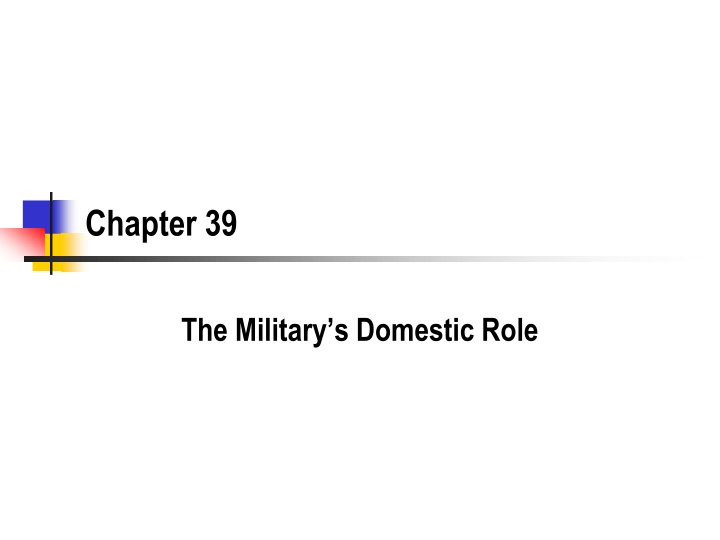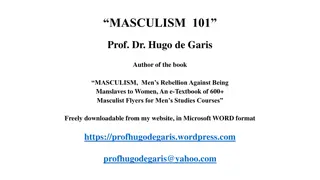The Military's Domestic Role: History and Legal Framework
Explore the historic fear of domestic military use in Anglo-American jurisprudence, the significance of state-based National Guard units, and the implications of acts like Posse Comitatus Act and 18 U.S. Code 1385. Delve into legal cases like Bissonette v. Haig and insights on civil actions post such rulings.
Uploaded on Dec 11, 2024 | 2 Views
Download Presentation

Please find below an Image/Link to download the presentation.
The content on the website is provided AS IS for your information and personal use only. It may not be sold, licensed, or shared on other websites without obtaining consent from the author.If you encounter any issues during the download, it is possible that the publisher has removed the file from their server.
You are allowed to download the files provided on this website for personal or commercial use, subject to the condition that they are used lawfully. All files are the property of their respective owners.
The content on the website is provided AS IS for your information and personal use only. It may not be sold, licensed, or shared on other websites without obtaining consent from the author.
E N D
Presentation Transcript
Chapter 39 The Military s Domestic Role
Concerns about the Domestic Use of the Military Why has there been a historic fear of the domestic use of the military in Anglo-Americian jurisprudence? Why did we have state-based national guard units? Is this a historic relic or a useful organizational structure? 2
Posse Comitatus Act (posse comitatus a body of men, typically armed, summoned by a sheriff to enforce the law.) What was behind the passing of the Posse Comitatus Act in 1878? 3
18 U.S. Code 1385 Use of Army and Air Force as posse comitatus Whoever, except in cases and under circumstances expressly authorized by the Constitution or Act of Congress, willfully uses any part of the Army or the Air Force as a posse comitatus or otherwise to execute the laws shall be fined under this title or imprisoned not more than two years, or both. What services are not included? Is there a private right of action? How would the president argue that it does not apply to him? 4
Bissonette v. Haig Is there a Bivens cause of action under the Posse Comitatus Act? The claim the several Defendants maintained or caused to be maintained roadblocks and armed patrols constituting an armed perimeter around the village of Wounded Knee. . . . Defendants actions, it is charged, seized, confined, and made prisoners (of plaintiffs) against their will. . . . 5
Ruling in Motion to Dismiss These allegations amount to a claim that defendants activities, allegedly in violation of the Posse Comitatus Act, were regulatory, proscriptive, or compulsory, in the sense that these activities directly restrained plaintiffs freedom of movement. No more is required to survive a motion to dismiss. 6
Civil Actions After Bissonette v. Haig No record case beyond the motion to dismiss What do we know about the Court s view on expanding Bivens? Is it surprising that Bissonette v. Haig did not generate more litigation? Is there FTCA liability? What makes it hard to bring these against state actors with the national guard? 7
Exclusionary Rule Cases These are the usual context for Posse Comitatus Act cases. The question: If the military is used improperly in a police investigation, does this trigger the exclusionary rule for any evidence that they participated in collecting? 8
United States v. Casper, 541 F.2d 1275 (8th Cir. 1976) . . . the District Court had found on a stipulated record that the following activities did not violate the Act: the use of Air Force personnel, planes, and cameras to fly surveillance; the advice of military officers in dealing with the disorder; and the furnishing of equipment and supplies. What is the statutory language? to execute the laws How is the court construing this? 9
United States v. Dreyer, 804 F.3d 1266 (9th Cir. 2015) the en banc Ninth Circuit divided over whether an agent of the Naval Criminal Investigative Service (NCIS) violated the Posse Comitatus Act when he conducted a criminal investigation into the distribution of child pornography on the Internet that, while targeted at military personnel, involved searches of all computers in the State of Washington that were sharing child pornography. (Majority found that it was a violation) 10
What is the Jurisdiction Problem with Dreyer? Does the PCA apply to the Navy? Why is the court applying the PCA? In 1986, the Department of Defense ( DoD ) issued a policy containing substantially identical content and stating that guidance on the Posse Comitatus Act ... is applicable to the Department of the Navy and the Marine Corps as a matter of DoD policy. Absent this policy (like a rule), the PCA would not apply. 11
Was Dreyer a Pure PCA Case? While the NCIS likely exceeded its authority, its actions seem to fit within Casper. The court did not look only at the PCA, but also considered DOD regs which were violated. If you only decided this on the PCA, you could find, as three judges did, that the evidence should not have been excluded. 12
What about the National Guard Units? Are they part of the Army/Air Force if they have not been nationalized? Is there specific statutory authorization? Congress has explicitly approved the states use of the militia for drug interdiction and counter-drug activities, so long as they remain under state control. 32 U.S.C. 112 (2012). 13
INSURRECTION ACT 10 U.S.C. 331- 335 (2012) 15
332. USE OF MILITIA AND ARMED FORCES TO ENFORCE FEDERAL AUTHORITY Whenever the President considers that unlawful obstructions, combinations, or assemblages, or rebellion against the authority of the United States, make it impracticable to enforce the laws of the United States in any State or Territory by the ordinary course of judicial proceedings, he may call into Federal service such of the militia of any State, and use such of the armed forces, as he considers necessary to enforce those laws or to suppress the rebellion. 16
333. MAJOR PUBLIC EMERGENCIES; INTERFERENCE WITH STATE AND FEDERAL LAW The President, by using the militia or the armed forces, or both, or by any other means, shall take such measures as he considers necessary to suppress, in a State, any insurrection, domestic violence, unlawful combination, or conspiracy, if it . . . (2) opposes or obstructs the execution of the laws of the United States or impedes the course of justice under those laws. . . . 17
334. PROCLAMATION TO DISPERSE Whenever the President considers it necessary to use the militia or the armed forces under this chapter, he shall, by proclamation, immediately order the insurgents or those obstructing the enforcement of the laws to disperse and retire peaceably to their abodes within a limited time. 18
10 U.S.C. 382 Emergency situations involving chemical or biological weapons of mass destruction (a) In general. The Secretary of Defense, upon the request of the Attorney General, may provide assistance in support of Department of Justice activities relating to the enforcement of section 175, 229, or 2332a of title 18 during an emergency situation involving a weapon of mass destruction. Department of Defense resources, including personnel of the Department of Defense, may be used to provide such assistance if (1) the Secretary of Defense and the Attorney General jointly determine that an emergency situation exists; and (2) the Secretary of Defense determines that the provision of such assistance will not adversely affect the military preparedness of the United States. (Could the president order this?) 19
Laird v. Tatum, 408 U.S. 1 (1972) Surveillance of Vietnam War protesters Respondents brought this class action in the District Court seeking declaratory and injunctive relief on their claim that their rights were being invaded by the Department of the Army's alleged surveillance of lawful and peaceful civilian political activity. The majority found no standing this was just a policy challenge. 20
Douglas Dissent The claim that respondents have no standing to challenge the Army s surveillance of them and the other members of the class they seek to represent is too transparent for serious argument. The surveillance of the Army over the civilian sector a part of society hitherto immune from its control is a serious charge. It is alleged that the Army maintains files on the membership, ideology, programs, and practices of virtually every activist political group in the country, including groups such as the Southern Christian Leadership Conference, Clergy and Laymen United Against the War in Vietnam, the American Civil Liberties Union, Women s Strike for Peace, and the National Association for the Advancement of Colored People. The Army uses undercover agents to infiltrate these civilian groups and to reach into confidential files of students and other groups. The Army moves as a secret group among civilian audiences, using cameras and electronic ears for surveillance. The data it collects are distributed to civilian officials in state, federal, and local governments and to each military intelligence unit and troop command under the Army s jurisdiction (both here and abroad); and these data are stored in one or more data banks. This was later documented by the Church Committee. 21
DOMESTIC USE OF MILITARY INTELLIGENCE TODAY 22
Northern Command (NORTHCOM) Northern Command (NORTHCOM) Post 9/11, the military is integrated with federal law enforcement and through cooperative agreements (fusion centers) with state and local authorities. The military can be used for nearly everything up to laying hands on someone to make an arrest. The traditional fears, especially by conservatives, about the domestic use of the military, have evaporated. 23
MARTIAL LAW: WHEN PLANNING FAILS In the middle of the eighteenth century, Blackstone described martial law as temporary excrescences bred out of the distemper of the state, and not any part of the permanent and perpetual laws of the kingdom. For martial law, which is built upon no settled principles, but is entirely arbitrary in its decisions, is . . . in truth and reality no law, but something indulged rather than allowed as a law. [2 William Blackstone, Commentaries *413.] 24
Ex Parte Milligan, 71 US 2 (1866) Civil war case How would the Union try cases in the South? This was a civil being tried by military commission in Indiana not a state in rebellion. Court found (after the war) that if the courts are functioning, you have to use them and all associated constitutional provisions. This is echoed in Reynolds. 25
Use of the Military on the Border Is this prohibited by the PCA? What are the arguments that it is authorized by other statutes or the Constitution? What is the problem with trying to attack it in court? 26























